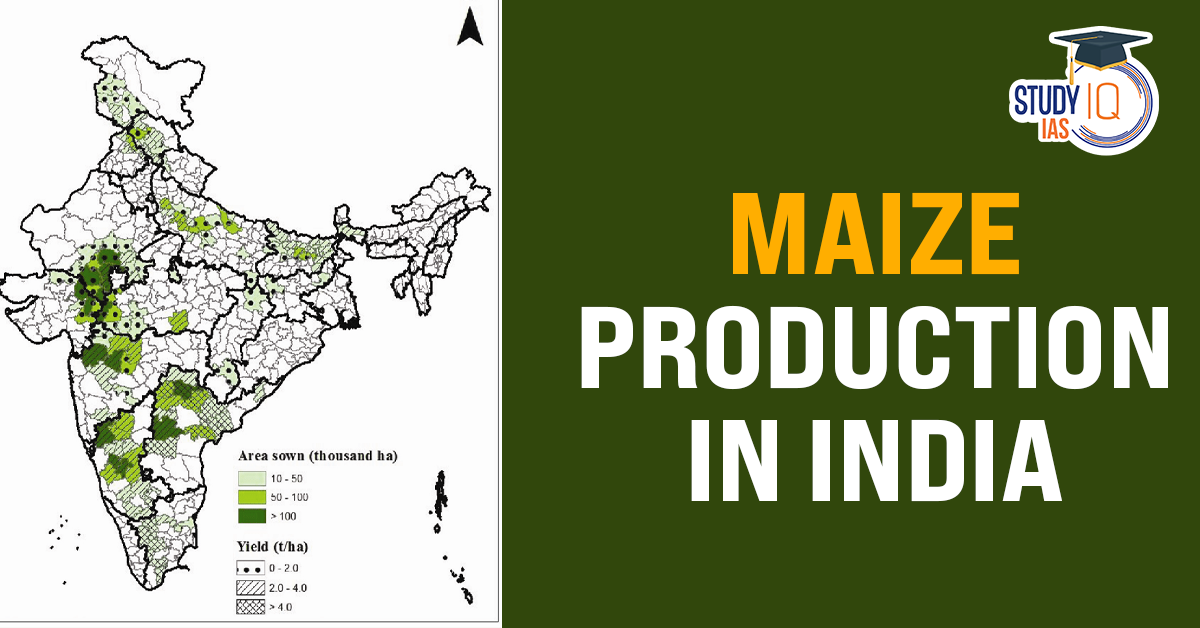Table of Contents
Maize (Zea mays) is one of the most versatile crops globally, serving as food, fodder, and industrial raw material. In India, maize is important in agriculture, contributing to food security and rural livelihoods. It ranks as the third most important cereal crop after rice and wheat.
Growing Conditions for Maize
- Climatic Requirements:
- Rainfall:
- Maize thrives in areas receiving 25–75 cm of rainfall.
- It is primarily a rainfed crop during the Kharif season.
- Excessive rainfall (>100 cm) is detrimental to its growth.
- Temperature:
- Optimal temperature: 21°C to 27°C.
- Extreme cold or heat can adversely affect growth and yield.
- Rainfall:
- Soil Requirements:
- Maize grows best in well-drained, fertile soils with a neutral pH (6.5–7.5).
- Loamy soils with good organic content are most suitable.
- It is sensitive to water logging, which can lead to root rot and reduced productivity.
- Water Needs:
- While consistent moisture is crucial throughout its growth, it cannot tolerate standing water.
- Effective irrigation management is necessary, especially in areas with erratic rainfall.
Maize Seasons in India
- Kharif Season (Rainy):
- Comprising 83% of the total maize area, this is the primary season for maize cultivation in India.
- Sown during the onset of monsoon (June-July) and harvested in September-October.
- Predominantly rainfed, Kharif maize faces risks from uneven rainfall and pest attacks.
- Rabi Season (Winter):
- Accounts for 17% of the maize area, mainly in irrigated regions.
- Sown in October-November and harvested in February-March.
- Yields are often higher than Kharif maize due to favorable climatic conditions and better management practices.
India’s Position in Global Maize Production
- Global Standing:
- India is the 6th largest producer of maize globally, following the USA, China, and Brazil.
- The USA, as the leading producer, dominates maize production, primarily for animal feed and biofuel.
- Contribution to Exports:
- India’s maize exports cater to Southeast Asian markets, including Vietnam, Malaysia, and Indonesia.
Top Maize Producing States in India
- Karnataka:
- Leading state in maize production due to its favorable semi-arid climate and adoption of hybrid seeds.
- Madhya Pradesh:
- Focuses on both food-grade and feed-grade maize.
- Maharashtra:
- A significant contributor with robust cultivation in rainfed regions.
- Rajasthan:
- Known for cultivating maize in semi-arid regions with minimal irrigation.
- Uttar Pradesh:
- A traditional maize-growing state with diversified uses for food, fodder, and starch production.
Importance of Maize in India
- Economic Significance:
- Serves as an important cash crop for farmers, especially in semi-arid regions.
- Contributes significantly to the poultry and livestock feed industry.
- Industrial Uses:
- Maize is a key ingredient in starch, ethanol, and corn oil production.
- Nutritional Value:
- Rich in carbohydrates, dietary fiber, and essential vitamins, maize is a staple food for many communities.
- Employment Generation:
- Provides livelihood to millions of farmers, laborers, and workers in allied industries like food processing and poultry.
Challenges in Maize Production
- Climate Vulnerability:
- Dependence on monsoons makes maize cultivation prone to droughts and floods.
- Pest and Disease Management:
- Fall Armyworm (Spodoptera frugiperda) has emerged as a major pest, threatening maize yields in India.
- Water Management:
- Sensitivity to water logging necessitates efficient irrigation systems.
- Market Linkages and MSP:
- Farmers often face difficulties in accessing markets and getting remunerative prices for their produce.
- Input Costs:
- Rising costs of hybrid seeds, fertilizers, and pesticides strain small and marginal farmers.
Government Initiatives for Maize Development
- National Food Security Mission (NFSM):
- Aims to increase maize productivity and ensure better resource use efficiency.
- Mission for Integrated Development of Horticulture (MIDH):
- Encourages diversification to maize cultivation in areas unsuitable for rice or wheat.
- Sub-Mission on Agricultural Mechanization (SMAM):
- Promotes mechanized practices to enhance productivity and reduce labor dependency.
- Rashtriya Krishi Vikas Yojana (RKVY):
- Provides funds for the adoption of high-yield varieties and advanced farming practices.
Way Forward
- Adoption of Hybrid and Drought-Resistant Varieties:
- Encouraging farmers to use improved seed varieties to boost productivity.
- Irrigation Infrastructure Development:
- Ensuring better irrigation facilities to support Rabi maize cultivation.
- Market and Value Chain Development:
- Strengthening post-harvest storage, processing units, and export channels.
- Pest Management:
- Developing integrated pest management strategies, especially for invasive pests like Fall Armyworm.
- Climate-Resilient Practices:
- Promoting agroforestry and crop diversification to reduce climate-related risks.
Conclusion
Maize is a crucial crop in India’s agricultural landscape, contributing to food, fodder, and industrial sectors. With proper policy interventions, technological advancements, and farmer support, India can enhance its maize production, ensuring sustainability and economic growth. For UPSC aspirants, understanding maize cultivation’s geographical, economic, and policy dimensions is vital for both prelims and mains examinations.
| UPSC PYQ |
Q. Consider the following statements : (2014)
2. Oil extracted from maize can be a feedstock for biodiesel. 3. Alcoholic beverages can be produced by using maize. Which of the statements given above is/are correct? (a) 1 only (b) 1 and 2 only (c) 2 and 3 only (d) 1, 2 and 3
Answer: D |
Sharing is caring!


 Indus Water Treaty 1960 Suspended by Ind...
Indus Water Treaty 1960 Suspended by Ind...
 5 Years of SVAMITVA Scheme and Its Benef...
5 Years of SVAMITVA Scheme and Its Benef...
 Places in News for UPSC 2025 for Prelims...
Places in News for UPSC 2025 for Prelims...





















